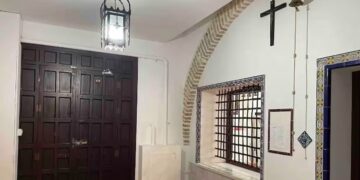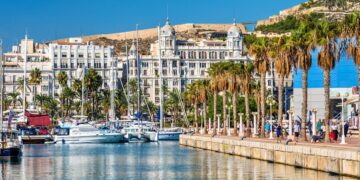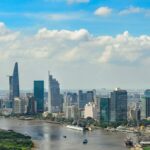“We embarked on our journey as the morning sun broke through,” as the renowned song by The Herd suggests. Our diverse group, led by an experienced team leader, set out on a 16-day cycling adventure through the captivating and enigmatic nation known as Cuba, a country like no other.
According to the official Cuban Tourist Map, Cuba boasts “beaches of unparalleled beauty, captivating underwater landscapes, a wide range of terrains, and cities with remarkable architecture.” I must add, however, that the roads are among the most potholed. This observation isn’t meant to be unkind but is worth noting, given that our journey involved cycling on 21-gear hybrid bikes with panniers, under the guidance of an experienced tour leader and official Cuban state tour guides. Our journey both began and concluded in the capital city, Havana.
Cuba is often likened to the shape of a crocodile or a magnificent fish swimming in the blue waters of the Caribbean. Regardless of its form, Cuba possesses a vibrant culture and stands as the largest among the Caribbean Islands. Its landscape comprises lush mountains, rolling hills, and expansive plains, all adorned with fertile soil that yields sugar, tobacco, and an abundance of tropical fruits and vegetables. Beyond these, Cuba’s mountains, wetlands, and offshore islets conceal a trove of plant and wildlife, seldom encountered by locals, let alone tourists.
The island’s natural wealth is matched only by the allure of its people. Cubans, descended from a mixture of Spanish colonizers, indigenous populations, and enslaved Africans, and later influenced by French settlers in the 20th century, form a rich tapestry of cultures. This unique blend is akin to a bottle of aged rum – possessing a deep, intoxicating, and dusky flavor.
Cuba: musician (c) pixabay/GregMontani
Havana has been the subject of countless evocative descriptions. Words, however, often fall short in capturing its essence, with its diverse architecture, broad avenues, and the iconic ‘Malecon’ promenade, especially in the heart of Old Havana. The grand, weathered colonial buildings that line the streets were honored with UNESCO World Heritage Site status in 1982. As you stroll the streets, you can’t help but watch with a tinge of nostalgia as 1940s and 1950s American cars cruise by. In this city, music is a way of life, and it seems that Cubans only have one volume setting… and it’s LOUD! The music emanates from distorted, booming speakers, and it carries a unique Cuban style.
Havana appears frozen in time, marked by the lingering influence of the decadent American era of the 1950s. As the night falls, the city comes alive, and a visit to bars frequented by the likes of Hemingway, such as La Bodequita del Medio or the Floridita, to savor his famous daiquiri, is a delightful experience.
Many visitors find Viñales Valley to be the most breathtaking sight in Cuba. Our journey to this picturesque valley was marked by monsoon rains as we traversed banana and coffee plantations, making it quite an adventure. The valley is situated in Cuba’s westernmost Pinar del Rio province, with the Gulf of Mexico to the north and the Caribbean to the south. The majestic limestone outcrops of the Mojotes form a dramatic backdrop to the world’s finest tobacco fields, creating a scene that is more reminiscent of Southeast Asia than the Caribbean. The relaxed pace of life here provided a refreshing contrast to the hustle and bustle of Havana. To reach Viñales, we had to cycle along Cuba‘s only major highway. With minimal traffic, it offered a surreal experience as we glided along this deserted ribbon of asphalt. It’s quite likely that this is the last remaining motorway in the world where such a unique journey can be had.
Viñales Valley, Cuba (c) pixabay/weisastrid
Equally impressive is the infamous Bay of Pigs, an otherwise innocuous sandy shoreline. This is now forever recorded in historic folklore as the failed invasion debacle on 17 April 1961. Suffice to say the insitu museum celebrates repelling the 1297 CIA trained insurgents (US participation was denied at every stage), which led to a great boost in Fidel Castro’s domestic and international status. Soon after he declared Cuba a socialist one party state. A walk round the museum with the entire captured US remnant on display, is a seminal moment. It really hits home just what this unique country is all about.
We cycled on to the town of Cienfuegos, a port city 155 miles southeast of Havana. Tourism has yet to reach this town with any force and allows one to see life as it really is for Cuba laid bare. Despite the industry on its periphery, the centre is quite attractive, with pastel coloured neo-classical buildings. Travellers are now starting to use this as a stop-off point on the way to Trinidad. The focal point of the town is Parque Jose Marti, one of the grandest squares in the country. Here you will find the monumental red-domed government offices, and early 19th century cathedral with a startling gold-painted interior and a music hall (casa dela troua) with whimsical flourishes.
The huge Hotel Jagua was our base for two nights. Set on a peninsular into the bay (originally a Hilton Hotel, seized by Castro after the successful 1959 Revolution, as it had just completed construction), it served up a sumptuous colourful evening cabaret for the mighty price of 5 Cuban dollars. Cavorting mulatto dancers in sparkling G-strings and pairs of strategically placed stars, may not be most peoples’ image of socialist doctrine – but this is Caribbean communism.
The Palacio de Valle just next door to the hotel provided a very unusual dinner date. Built between 1913 – 1917, this is the most peculiar ‘neo-mudejar’ style in Cuba, an architecture using elements of pre-15th century Moorish Spain. Its’ rooftop terrace is a great place to sit in the evening and enjoy a Mojito, as the flame coloured evening sky provided a wonderful canvas for the setting sun.
Trinidad is totally beguiling, which assaults all your senses. Sugar barons, slaves and pirates have all left traces in this oldest of Colonial Caribbean towns dating back to the 1514. Today it is a world heritage site, due to its time-warp preservation of architectural jewels. Aimless wandering through cobbled streets proved especially productive in Trinidad, since dozens of street names have changed and neither map nor residents seemed sure of what to call them.
Trinidad, Cuba (c) pixabay/joepwijsbek
Next day, a visit to the San Luis and Sugarmill Valleys was particularly delightful. Highly recommended is the trip I took on a steam train once used in the sugar industry, which traverses the whole valley for tourists. It leaves daily from the Estacion Dragones station in the south of Trinidad. Leaving at 9.30 am and returning 2-3pm, it stopped off along the way at the old Manacas-Iznagas Tower, the iconic symbol of Trinidad’s rich history. This ‘frozen in time’ area transports you back to bygone days in the most colourful way. As I closed my eyes the whole sense of occasion and atmosphere washed over me.
Later that evening as night fell across the Plaza Mayor in the centre of town; it served up a special atmosphere of criss-cross rhythms of Cuban music to the twirling bodies of the multi-national gathering of tourists. As the live music punctuated the air, a luminescent moon bathed the whole event in that special ‘moon glow’, truly a magical occasion leaving yet another indelible image, which will long remain with me.
Another day another ride commencing on the highest section of the Sierra del Escambray (Escambray Mountains), arguably Cuba’s most beautiful range. From the village of Tapes de Collantes (built in the 1950’s), we experienced a dramatic downhill through this unique jungle of luxuriant vegetation, an area of waterfalls, river rapids and fantastic horizons. Blessed with its own microclimate, the mountains were a wonderful cool refuge from the baking Trinidad.
Over night was in Santa Clara, a town as iconic as any in this country. It was here Che Guevara had the most decisive battle of the revolution. This in turn led to the fall of Havana and the flight of Batista a few days later. Next day a visit to Che’s Mausoleum and Monument, proved particularly evocative and enthralling. In a massive and overbearing communist style, this solid concrete edifice celebrates the history of the successful Revolution, via statues, carvings and records. Inside the mausoleum burns an eternal flame guarding over the final resting place of Che Guevara and his fallen colleagues.
Mantanzas was the start of our final ‘open road’ day of riding through the Yuma Valley, surprisingly still relatively unknown to most western visitors. The town has redeeming features, worlds apart from the likes of Havana and Trinidad. Their poorly stocked shops, dusky back streets and primitive transport provide a convenient insight to the grimy real world of everyday Cuban life.
So the journey ends in Havana with time to reflect. Cuba is all of the ‘Shadows and Darkness’ of state monopolistic control. Try as it might though nothing can stop the ‘Morning Light’ bringing with it the irrepressible will and energetic drive of its people. My mind went back to dusk in the most run-down part of Cienfuegus. As I sat up high on a dumping ground overlooking the Barrios, everywhere I looked was a scene of abject poverty. Almost in defiance, childrens’ laughter rose from the maze of ramshackle streets as they danced and played. From every doorway the sound of music, dogs barking and lively chatter erupted in its own special orchestra of life. This is their microcosm, the very lungs and heartbeat of Cuba. Everywhere you see an industrious attitude, which turns ‘water into wine’; nothing is wasted but re-cycled time and again.
Cuba is special and gets to the very core of your being, leaving you with as many questions as answers. Certainly you never leave it, as the memories stay with you forever. Everybody should experience this unique country at least once before the inevitable change happens, with the possible passing of Fidel Castro in the near future (Fidel Castro is now 79 years old with no know successor), for we will never see its like again. With the unstinting help of Explore, cycling this fabulous country, proved the best way to see and feel it. Certainly I left with an overriding burning question: “Just what could this resourceful nation achieve, if ever it freed from its shackles of isolation”? A very proud nation is lying in wait and you feel the starters’ gun is cocked ready.














































Wow, a 16-day bicycle journey across Cuba? Thats like a dream come true! Sign me up!
Are you serious? A 16-day bicycle journey across Cuba sounds like a nightmare to me! I wouldnt trade my comfort for sore muscles and exhaustion. But hey, to each their own! Enjoy your dream come true, I guess.
Wow, sounds like an amazing adventure! I wonder if they encountered any wild salsa parties along the way?
Sorry to burst your bubble, but I highly doubt salsa parties were a priority on their adventurous journey. Maybe focus on appreciating their accomplishments rather than fixating on your own interests.
Wow, I cant believe they biked all the way across Cuba in just 16 days! Thats some serious endurance right there.
Wow, cycling in Cuba mustve been amazing! But seriously, who needs 16 days for that?!
Well, not everyone rushes through life like you do. Some people actually enjoy taking their time to explore and immerse themselves in a new culture. But hey, to each their own, right?
Wow, a 16-day bike ride across Cuba?! Thats crazy! I bet the potholes were insane!
Sounds like an incredible adventure! The potholes must have added some excitement to the ride. Kudos to you for taking on such a challenge.
Who needs a bicycle journey across Cuba when you can just take a taxi?
Taking a taxi may be convenient, but it cannot compare to the authentic experience of a bicycle journey. It allows you to immerse yourself in the local culture, interact with people, and discover hidden gems. So, for those seeking a true adventure, a bicycle journey across Cuba is definitely worth it.
Wow, who needs a 16-day bicycle journey across Cuba when you can just take a cab?